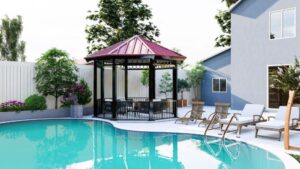When it comes to installing a swimming pool in your backyard, you want to make sure you’re making the right choice. That’s why we’re here to help you decide between two of the most popular options: fiberglass and concrete pools
We’ll dive into the advantages and disadvantages of each type of pool, so you can make an informed decision on which one is the best choice for your home. So, let’s jump right in and compare fiberglass vs concrete pools!
What is a Fiberglass Pool?

Fiberglass pools are one-piece units manufactured in a factory using a mold. This mold includes the pool’s sides and bottom in a variety of shapes and sizes. These fiberglass pools are made of materials other than fiberglass and are shipped across the country.
Each of these molded swimming pools is made up of several layers that contribute to the overall strength and support of the design. These layers combine to form an extremely tough shell that can include features such as built-in seating, steps, and so on. Fiberglass pools come in a variety of shapes, including circles, rectangles, kidneys, ovals, and a combination of shapes.
What is a Concrete Pool?

Spraying either gunite or shotcrete results in a concrete pool shell. Unlike shotcrete, which is already wet, gunite is a dry mix with water in the sprayer. If carried out correctly, these two methods have no discernible difference in quality and yield the same outcome.
It takes time for the concrete to cure completely after it has been sprayed on. In general, it doesn’t dry. A protracted process known as curing causes it to harden and strengthen. This takes roughly 28 days for a pool shell.
Comparing Fiberglass Vs Concrete Pool
Let’s take a closer look at the differences between fiberglass and concrete pools:

| Fiberglass | Concrete | |
|---|---|---|
| Cost | Although we do not recommend DIYing a fiberglass pool, some people do choose to install the pool themselves, which can cost anywhere from $12,000 to $30,000. Most fiberglass pool projects cost between $45,000 and $85,000 for both manufacturing and installation, but they can cost much more depending on the landscaping, accessories, and water features you choose. |
Concrete pool construction typically costs between $50,000 and $100,000 in the beginning. Concrete pools require a lot of TLC to stay in good shape, so budget for long-term maintenance such as acid washing, refinishing, and energy usage. A concrete pool requires extensive maintenance, which drives up the annual maintenance cost to over $25,000. |
| Installation time | The fiberglass pool shell will be manufactured away from the site. After transporting the pool to your backyard, it will be installed and ready for swimming in about two days. It will take another week or two to complete the patio and decking. The process usually takes 3-5 weeks from start to finish. | Building a concrete pool typically takes 3 to 6 months and involves the gunite method. Every time you see your destroyed backyard, you might want to cry because that much time has passed. |
| Durability | The pool’s frame and gelcoat finish are both incredibly durable. As salt has no detrimental effects on the fiberglass shell, a salt chlorine generator can also be used for low maintenance and silkier water. | The structure of a concrete pool, as well as the actual concrete, is extremely durable. Simple plaster and other interior concrete pool finishes are both strong enough to resist scuffing from toys, dogs, or tree branches. However, the waterline tile must be replaced and the pool must be replastered every 10 to 15 years. If you use a salt chlorine generator, the dissolved salt in the water will shorten the life of a plaster-based interior finish even more (which includes aggregate). However, salt water has no effect on the finish of a tile. |
| Interior surface texture | The interior surface of a fiberglass pool is referred to as the gel coat. To touch it is pleasant. Even though the anti-slip texture on steps and tanning ledges is designed, it is not rough. | Plaster, which severely scrapes your skin, is the roughest interior surface for concrete. Although exposed aggregate (like pebbles) isn’t as rough, the sharp protrusions can be uncomfortable to walk on. This is where polished aggregate can help. Tile has the smoothest finish, but it also has the highest price. |
| Algae | A fiberglass pool’s gel coat is smooth and algae-resistant, with only microscopic pores, so algae cannot burrow into it. | Algae thrive in concrete’s many pores and cavities. The pool should be brushed at least once a week. |
| Hands-on maintenance | Because the gel coat has no effect on the pH of the water, it is rarely necessary to add acid to balance it. You must still test your water chemistry once a week. | Because the alkalinity of concrete raises the pH of the water, you must add muriatic acid (hydrochloric acid) every day. You should also clean the pool’s entire surface with a steel brush at least once a week to remove any surface algae. |
Conclusion
So, fiberglass vs concrete pool: which pool is the best choice for you? It ultimately comes down to personal preference and budget. Fiberglass pools are easier to maintain and install and provide a sleeker, more modern look. Meanwhile, concrete pools are more customizable and can fit a variety of backyards and budgets. In the end, both materials are great choices for in-ground pool installation, and both have their advantages and disadvantages. So, it’s up to you to decide which one is the perfect fit for your backyard oasis.








